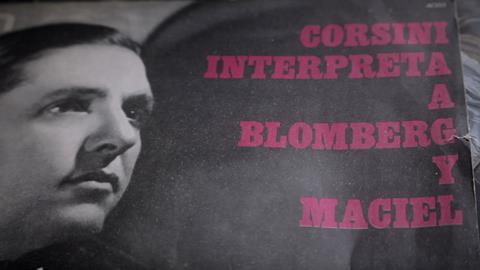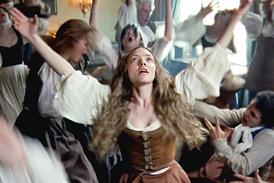Mariano Llinas unpicks the music during a re-recording of the classic Argentinian LP

Dir. Mariano Llinás. Argentina. 2021. 100 mins.
Argentinian writer-director Mariano Llinas has a reputation as an auteur for viewers with intrepid tastes – and with time on their hands. He’s known for features Extraordinary Stories (2008) and La Flor (2018), which run at four and 13 hours-plus respectively, and which build mazes of narrative upon narrative in a way that is perhaps cinema’s closest equivalent to the great Latin American experimental story spinners like Roberto Bolaño. Llinas’s latest work, screening in Rotterdam, following its premiere in SEMINCI, is a much more concise and ostensibly simpler proposition, but typically playful and perplexing. Meta-documentary Corsini Sings Blomberg And Maciel captures the re-recording of a classic LP of Argentinian songs and unpicks the complex, even bewildering historical references they contain. There’s plenty here among the rather thinly spread material to enthral lovers of South American song, while fans of the postmodern touch will relish the formal winks, although Llinas’s ludic, teasingly tricksy approach might leave some viewers grinding their teeth.
Far from being a conventionally functional documentary about music and history, this deliberately wayward venture makes a point of eschewing obvious strategies
The starting point is a LP named Corsini Sings Blomberg And Maciel, a classic 1929 recording by the great tango singer Ignacio Corsini of songs written by lyricist Hector Pedro Blomberg and composer Enrique Maciel. On July 9, Argentina’s Independence Day, Llinás and DoP Agustin Mendilaharzu meet up with contemporary singer Pablo Dacal and a group of guitarists as they re-record the Blomberg-Maciel numbers. But Dacal, Mendilaharzu and Llinas also come together on a separate occasion to record the vocal commentary for the film we’re watching, clustering round a microphone to puzzle over some of the arcane vocabulary used in the songs. Take the much loved ‘La Pulpera de Santa Lucia’ – what’s a pulpera? A woman who works in a pulperia, or neighbourhood grocery, of course. And that’s even before we get to the specialist terms arising from a particular period of Argentine history, the reign of Juan Manuel de Rosas (1793-1877), governor of Buenos Aires province and leader of the Argentine Confederation.
Many of the songs romanticise the Mazorca, Rosas’s armed militia, with these ballads of bloodletting and martyrdom couched in gorgeously lyrical music that makes a paradoxical fit with their troubling content. Standing at the microphone, Llinas maintains that Rosas was a dictator, Dacal – apparently for the purposes of cinematic argument – disagrees, and Mendilaharzu, caught (sometimes literally) between the two of them, hedges his bets. Throughout, as Dacal and the guitarists – Gustavo Semmartin, Julio Sleiman, Muhammad Habbibi Guerra - record take after take of the numbers in an atmospheric old Buenos Aires house, the film explains some of the arcane words and specific events referred to in the songs, and scans old city maps and now-forgotten place names. Intermittently, Llinas and Mendilarzu are seen driving round Buenos Aires trying to shoot specific sites, but expressly make it a frustrating process, staying in their car and fussing about vans and pedestrians that get in the way of a passable shot.
Far from being a conventionally functional documentary about music and history, this deliberately wayward venture makes a point of eschewing obvious strategies – like interviewing historians – and instead mulls in close-up over old books, maps, sheet music to glean insight from a very non-specialist perspective. Llinas also enlists various performers to don rudimentary costumes and play the roles of the songs’ mazorqueros, guitarreras, bordereras and other characters for black and white inserts.
The film is highly self-reflexive, very much in keeping with Llinas’s fiction works (La Flor similarly contained a long section reflecting on singers and the recording process). In fact, viewed in a non-cinematic light, this film is perhaps not altogether as outré as it seems: we could almost be watching the filmed version of one of today’s podcasts in which argumentative music nerds pontificate over the meaning of favourite songs. Even as a music film, Corsini Sings… - with its repeated takes that some might feel surplus to requirements – is not so far from the methods of Godard’s 1968 Rolling Stones study The Rolling Stones: Sympathy for the Devil, or even Peter Jackson and Michael Lindsay-Hogg’s recent Llinás-length The Beatles: Get Back.
Corsini Sings… is nothing if not educational, though, both about history and the processes of myth-making. And the performances themselves are mesmerising, with their intricate guitar patterns, oddly bouncy melodies (given the often harsh subject matter) and the vocals of the dashingly cape-wearing Dacal, who mixes the high romantic tango style with airier modern inflections. You may emerge still not entirely sure how the Unitarians related to the Federals, or who Paulina Varela and the bordadora of San Telmo were, but you may well find yourself addicted to these beautiful songs (now available, in fact, as Dacal’s album Cancionero Federal).
Production company: El Pampero Cine
International sales: El Pampero Cine producción@elpamperocine.com.ar
Producer: Laura Citarella
Screenplay: Mariano Llinás, Agustín Mendilaharzu, Pablo Dacal
Cinematography: Augustin Mendilaharzu, Ignacio Masllorens
Editor: Ignacio Codino
Music: Pablo Dacal
Main Cast: Pablo Dacal, Augustin Mendilaharzu, Mariano Linas, Gustavo Semmartin, Julio Sleiman, Muhammad Habbibi Guerra






















